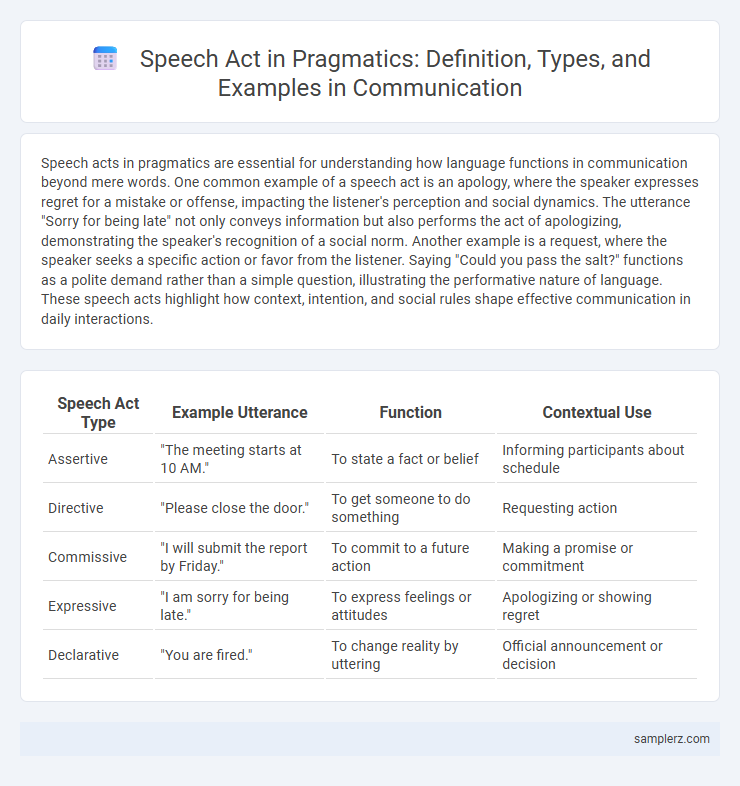Speech acts in pragmatics are essential for understanding how language functions in communication beyond mere words. One common example of a speech act is an apology, where the speaker expresses regret for a mistake or offense, impacting the listener's perception and social dynamics. The utterance "Sorry for being late" not only conveys information but also performs the act of apologizing, demonstrating the speaker's recognition of a social norm. Another example is a request, where the speaker seeks a specific action or favor from the listener. Saying "Could you pass the salt?" functions as a polite demand rather than a simple question, illustrating the performative nature of language. These speech acts highlight how context, intention, and social rules shape effective communication in daily interactions.
Table of Comparison
| Speech Act Type | Example Utterance | Function | Contextual Use |
|---|---|---|---|
| Assertive | "The meeting starts at 10 AM." | To state a fact or belief | Informing participants about schedule |
| Directive | "Please close the door." | To get someone to do something | Requesting action |
| Commissive | "I will submit the report by Friday." | To commit to a future action | Making a promise or commitment |
| Expressive | "I am sorry for being late." | To express feelings or attitudes | Apologizing or showing regret |
| Declarative | "You are fired." | To change reality by uttering | Official announcement or decision |
Introduction to Speech Acts in Pragmatics
Speech acts in pragmatics represent communicative actions such as asserting, requesting, promising, and apologizing, where meaning extends beyond literal words to speaker intentions. For example, a request like "Can you pass the salt?" functions not just as a question but as a polite directive seeking cooperation. Understanding speech acts enables effective interpretation of language use in social contexts by analyzing illocutionary force and perlocutionary effects.
The Role of Speech Acts in Communication
Speech acts, such as asserting, questioning, commanding, and promising, directly influence communication by performing actions through language. In pragmatics, these acts enable speakers to convey intentions beyond literal meanings, shaping interactions and social relationships. Understanding speech acts helps decode implicit messages and enhances effective communication in various contexts.
Types of Speech Acts: An Overview
Speech acts in pragmatics are classified into types such as locutionary acts, illocutionary acts, and perlocutionary acts, each serving distinct communicative functions. Locutionary acts involve the actual utterance and its literal meaning, while illocutionary acts represent the speaker's intention, including asserting, questioning, commanding, and promising. Perlocutionary acts refer to the effect the utterance has on the listener, such as persuading, deterring, or inspiring action.
Examples of Assertive Speech Acts
Assertive speech acts in pragmatics involve statements that convey beliefs or descriptions about the world, such as assertions, claims, or descriptions. Examples include saying "The sky is blue," which asserts a fact, or "I believe it will rain tomorrow," expressing a personal belief or prediction. These speech acts aim to describe a state of affairs and commit the speaker to the truth of the proposition presented.
Examples of Directive Speech Acts
Directive speech acts involve utterances intended to cause the listener to take a specific action, such as requests, commands, or suggestions. For example, when someone says, "Please close the window," they are using a directive speech act to prompt the listener to perform the action of closing the window. Other common examples include orders like "Submit your report by Monday" or suggestions like "You should try the new restaurant downtown.
Examples of Commissive Speech Acts
Commissive speech acts in pragmatics involve commitments by the speaker to future actions, such as promising, offering, or pledging. For example, when someone says, "I will meet you at the library at 5 PM," they are explicitly committing to a future event. These acts are essential for establishing trust and cooperation in communication by clearly expressing intentions.
Examples of Expressive Speech Acts
Expressive speech acts convey the speaker's feelings or attitudes, such as thanking, apologizing, congratulating, or greeting. For example, saying "Thank you for your help" expresses gratitude, while "I'm sorry for being late" communicates an apology. These utterances directly reflect the speaker's emotional state and establish interpersonal connections in communication.
Examples of Declarative Speech Acts
Declarative speech acts perform a change of state through the utterance itself, such as when a judge pronounces a sentence or a priest declares a couple married. Examples include statements like "I now pronounce you husband and wife," which legally formalize a marriage, or "You are fired," which terminates employment. These utterances carry the power to alter social or legal statuses directly through their expression.
Speech Acts in Everyday Conversations
Speech acts in everyday conversations include requests, promises, apologies, and compliments, each performing a specific communicative function that shapes interaction. For instance, requesting information or assistance helps achieve immediate goals, while promises strengthen social bonds through implied commitments. These acts rely heavily on context and shared knowledge to convey intended meaning beyond literal words.
The Importance of Context in Understanding Speech Acts
Speech acts in pragmatics reveal how meaning extends beyond literal words, relying heavily on contextual cues such as speaker intent, social relationships, and situational factors to convey messages effectively. For example, the utterance "Can you pass the salt?" functions as a request rather than a question, with interpretation dependent on the immediate dining context. Understanding context allows interlocutors to correctly interpret directives, promises, or apologies, highlighting its crucial role in successful communication and avoiding misunderstandings.

example of speech act in pragmatics Infographic
 samplerz.com
samplerz.com